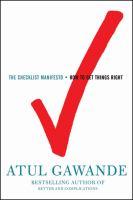
 The title says it all. At some point in time, all of us have made a list: things to do, grocery, or books to read. Some of us have a love-hate relationship with checklists, but most of us see the importance of then and they are used all over the world. Gawande argues that checklists have two main purposes: to create efficiency, and accuracy. In a world of great and increasing complexity, a simple checklist can reduce human fallibility, the medical field being the most obvious example. Grievous errors could be eliminated by checklists adopted in hospitals everywhere, helping doctors and nurses and saving patients’ lives or limbs.
The title says it all. At some point in time, all of us have made a list: things to do, grocery, or books to read. Some of us have a love-hate relationship with checklists, but most of us see the importance of then and they are used all over the world. Gawande argues that checklists have two main purposes: to create efficiency, and accuracy. In a world of great and increasing complexity, a simple checklist can reduce human fallibility, the medical field being the most obvious example. Grievous errors could be eliminated by checklists adopted in hospitals everywhere, helping doctors and nurses and saving patients’ lives or limbs.
Checklists came into wide use during the WWI. During that era airplanes became more complicated and checklists were implemented by pilots to avoid major mistakes. Later they appeared in the medical field and eventually in all professions. In the field of science and technology it prevents little things from bringing down the whole endeavor. For many humans a written down list of tasks enforces discipline.
The Checklist Manifesto is written with humor, saving readers from a potentially dry subject and is a great read for everyone interested in expanding their knowledge and learning how things evolve.
Atul Gawande is a general surgeon and an assistant professor at Harvard Medical School, as well as a staff writer for The New Yorker.
